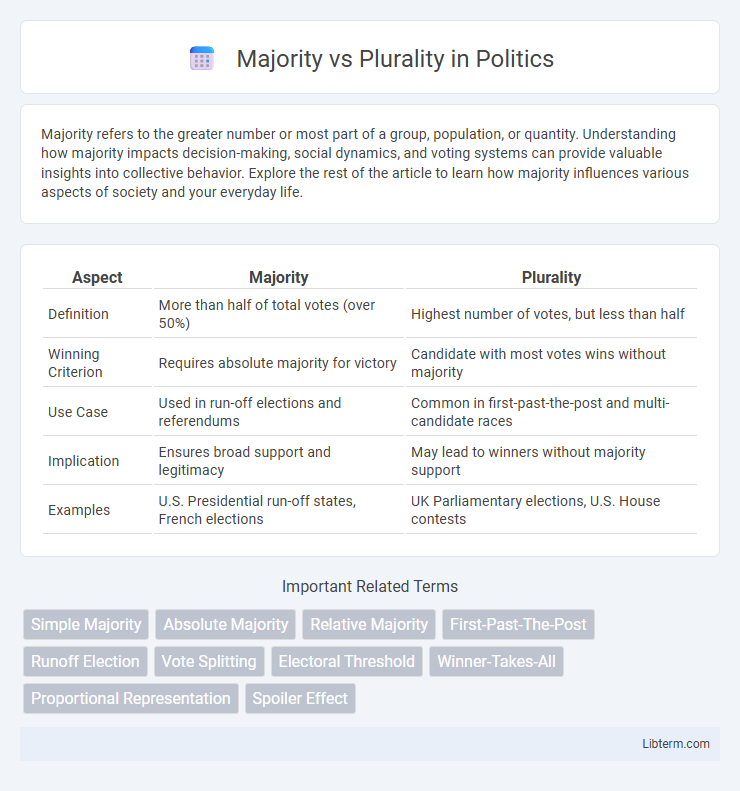Majority refers to the greater number or most part of a group, population, or quantity. Understanding how majority impacts decision-making, social dynamics, and voting systems can provide valuable insights into collective behavior. Explore the rest of the article to learn how majority influences various aspects of society and your everyday life.
Table of Comparison
| Aspect | Majority | Plurality |
|---|---|---|
| Definition | More than half of total votes (over 50%) | Highest number of votes, but less than half |
| Winning Criterion | Requires absolute majority for victory | Candidate with most votes wins without majority |
| Use Case | Used in run-off elections and referendums | Common in first-past-the-post and multi-candidate races |
| Implication | Ensures broad support and legitimacy | May lead to winners without majority support |
| Examples | U.S. Presidential run-off states, French elections | UK Parliamentary elections, U.S. House contests |
Understanding Majority and Plurality: Key Definitions
Majority refers to more than half of the total votes or members in a group, ensuring a decisive and clear preference. Plurality means having the largest number of votes among options but not necessarily exceeding half, often leading to winners without an absolute majority. Understanding majority and plurality is essential in electoral systems, decision-making processes, and voting mechanisms to accurately interpret outcomes and legitimacy.
Historical Origins of Majority and Plurality Concepts
The concepts of majority and plurality have distinct historical origins rooted in ancient political and legal systems. Majority, derived from Latin "majoritas," originally signified the greater part or more than half, emphasizing absolute dominance in decision-making processes, especially in Roman law and medieval councils. Plurality, emerging later in electoral theory, refers to obtaining the highest number of votes without necessarily achieving a majority, reflecting evolving democratic practices in modern parliamentary systems.
Majority vs Plurality: Core Differences Explained
Majority means receiving more than half of the total votes cast, ensuring over 50% support, whereas plurality refers to having the highest number of votes without necessarily surpassing half. In elections, a majority secures decisive victory by exceeding 50%, while a plurality can win with less than 50% if opponents have fewer votes. Understanding this distinction is crucial in electoral systems to determine whether a candidate wins outright or a runoff is needed.
Majority and Plurality in Electoral Systems
In electoral systems, a majority refers to a candidate or option receiving more than half of the total votes, ensuring clear and decisive outcomes. A plurality involves obtaining the highest number of votes but not necessarily exceeding half, which can lead to winners without absolute support. Majority voting systems often require runoff elections to secure more than 50% support, while plurality systems allow a candidate to win outright with the largest vote share, even if it is less than a majority.
Real-World Examples: Majority vs Plurality Outcomes
In electoral systems, a majority means a candidate receives over 50% of votes, ensuring clear support, seen in U.S. presidential elections requiring an electoral majority. Plurality refers to the highest vote count without a majority, common in UK parliamentary elections where a candidate wins with fewer than half the votes. These distinctions influence outcomes, with plurality often allowing victories in fragmented fields, while majority systems emphasize broader consensus.
Advantages and Disadvantages of Majority Rule
Majority rule ensures decisions reflect the preference of more than half the participants, promoting fairness and clear mandates in democratic processes. This method can lead to stable governance by reducing the likelihood of fragmented outcomes seen in plurality systems where the winner may lack broad support. However, majority rule may marginalize minority groups, risking exclusion and potential social discord if their interests are consistently overlooked.
The Impacts of Plurality Voting on Representation
Plurality voting often leads to a winner who secures only the highest number of votes, not necessarily an absolute majority, which can result in less representative outcomes for diverse electorates. This system tends to exaggerate the dominance of major parties while marginalizing smaller groups, reducing the proportionality of representation in legislative bodies. Consequently, plurality voting can contribute to voter dissatisfaction and lower turnout due to perceptions of unbalanced political power.
Global Applications: Majority and Plurality Around the World
Majority and plurality voting systems are implemented worldwide, influencing electoral outcomes and governance structures across democracies and other political systems. Majority voting, requiring over 50% of votes, is prevalent in countries like the United States and France for presidential elections, ensuring clear mandates. Plurality voting, which declares the candidate with the most votes the winner regardless of majority, is common in nations such as the United Kingdom and Canada, impacting multi-party elections and sometimes leading to minority rule.
Controversies and Debates: Which System Is Fairer?
The debate between majority and plurality voting systems centers on fairness and representation, with critics arguing that plurality can result in winners without majority support, skewing democratic legitimacy. Majority systems, requiring over 50% of votes, promote consensus but can lead to runoff elections, prolonging decision processes and increasing costs. Controversies persist as scholars and political analysts assess whether majority systems better reflect voter intent or if plurality's simplicity outweighs potential distortions in competitive, multi-candidate races.
Future Trends in Electoral Reform: Majority vs Plurality
Future trends in electoral reform increasingly emphasize transitioning from plurality to majority voting systems to enhance representational legitimacy and reduce electoral fragmentation. Majority voting methods, such as ranked-choice voting and runoff elections, are gaining traction to ensure elected candidates secure broad voter support, reflecting a more accurate representation of public will. Research indicates that majority systems can lead to more stable governance and improved voter satisfaction compared to traditional plurality models dominated by vote splitting and minority winners.
Majority Infographic

 libterm.com
libterm.com